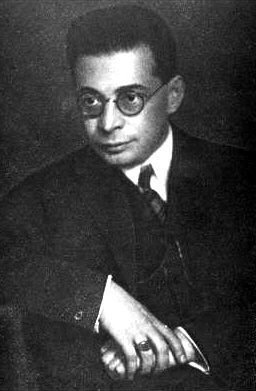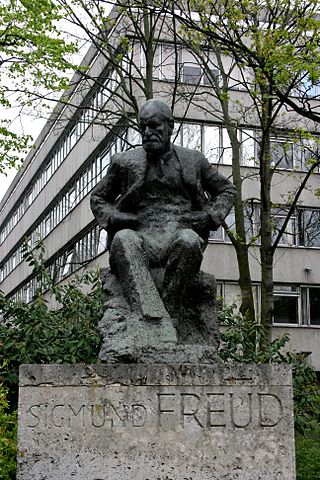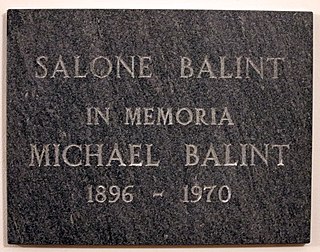Related Research Articles
Psychoanalysis is a set of theories and therapeutic techniques that deal in part with the unconscious mind, and which together form a method of treatment for mental disorders. The discipline was established in the early 1890s by Sigmund Freud, whose work stemmed partly from the clinical work of Josef Breuer and others. Freud developed and refined the theory and practice of psychoanalysis until his death in 1939. In an encyclopedia article, he identified the cornerstones of psychoanalysis as "the assumption that there are unconscious mental processes, the recognition of the theory of repression and resistance, the appreciation of the importance of sexuality and of the Oedipus complex." Freud's colleagues Alfred Adler and Carl Gustav Jung developed offshoots of psychoanalysis which they called individual psychology (Adler) and analytical psychology (Jung), although Freud himself wrote a number of criticisms of them and emphatically denied that they were forms of psychoanalysis. Psychoanalysis was later developed in different directions by neo-Freudian thinkers, such as Erich Fromm, Karen Horney, and Harry Stack Sullivan.

Wilfred Ruprecht Bion DSO was an influential English psychoanalyst, who became president of the British Psychoanalytical Society from 1962 to 1965.
Group psychotherapy or group therapy is a form of psychotherapy in which one or more therapists treat a small group of clients together as a group. The term can legitimately refer to any form of psychotherapy when delivered in a group format, including art therapy, cognitive behavioral therapy or interpersonal therapy, but it is usually applied to psychodynamic group therapy where the group context and group process is explicitly utilized as a mechanism of change by developing, exploring and examining interpersonal relationships within the group.

Otto Rank was an Austrian psychoanalyst, writer, and philosopher. Born in Vienna, he was one of Sigmund Freud's closest colleagues for 20 years, a prolific writer on psychoanalytic themes, editor of the two leading analytic journals of the era, managing director of Freud's publishing house, and a creative theorist and therapist. In 1926, Rank left Vienna for Paris and, for the remainder of his life, led a successful career as a lecturer, writer, and therapist in France and the United States.
Gestalt therapy is a form of psychotherapy that emphasizes personal responsibility and focuses on the individual's experience in the present moment, the therapist–client relationship, the environmental and social contexts of a person's life, and the self-regulating adjustments people make as a result of their overall situation. It was developed by Fritz Perls, Laura Perls and Paul Goodman in the 1940s and 1950s, and was first described in the 1951 book Gestalt Therapy.

The Tavistock and Portman NHS Foundation Trust is a specialist mental health trust based in north London. The Trust specialises in talking therapies. The education and training department caters for 2,000 students a year from the United Kingdom and abroad. The Trust is based at the Tavistock Centre in Swiss Cottage. The founding organisation was the Tavistock institute of medical psychology founded in 1920 by Dr. Hugh Crichton-Miller.

Psychodynamic psychotherapy and psychoanalytic psychotherapy are two categories of psychological therapies. Their main purpose is revealing the unconscious content of a client's psyche in an effort to alleviate psychic tension, which is inner conflict within the mind that was created in a situation of extreme stress or emotional hardship, often in the state of distress. The terms "psychoanalytic psychotherapy" and "psychodynamic psychotherapy" are often used interchangeably, but a distinction can be made in practice: though psychodynamic psychotherapy largely relies on psychoanalytical theory, it employs substantially shorter treatment periods than traditional psychoanalytical therapies. Psychodynamic psychotherapy is evidence-based; the effectiveness of psychoanalysis and its relationship to facts is disputed.

Michael Balint was a Hungarian psychoanalyst who spent most of his adult life in England. He was a proponent of the Object Relations school.
Intensive short-term dynamic psychotherapy (ISTDP) is a form of short-term psychotherapy developed through empirical, video-recorded research by Habib Davanloo.

S. H. Foulkes was a German-British psychiatrist and psychoanalyst. He developed a theory of group behaviour that led to his founding of group analysis, a variant of group therapy. He initiated the Group Analytic Society, and the Institute of Group Analysis (IGA) in London. In 1933, owing to his Jewish descent, Foulkes emigrated to England. In 1938, he was granted British citizenship and changed his name to S. H. Foulkes.
David Huntingford Malan was a British psychoanalytic psychotherapy practitioner and researcher recognized for his contribution to the development of psychotherapy. He promoted scientific spirit of inquiry, openness, and simplicity within the field. He is also noted for his development of the Malan triangles, which became a rubric in which therapists can reflect upon what they are doing and where they are in relational space at any given moment.
Resistance, in psychoanalysis, refers to the client's defence mechanisms that emerge from unconscious content coming to fruition through process. Resistance is the repression of unconscious drives from integration into conscious awareness.
Psychoanalytic dream interpretation is a subdivision of dream interpretation as well as a subdivision of psychoanalysis pioneered by Sigmund Freud in the early 20th century. Psychoanalytic dream interpretation is the process of explaining the meaning of the way the unconscious thoughts and emotions are processed in the mind during sleep.
Donald Meltzer (1922–2004) was a Kleinian psychoanalyst whose teaching made him influential in many countries. He became known for making clinical headway with difficult childhood conditions such as autism, and also for his theoretical innovations and developments. His focus on the role of emotionality and aesthetics in promoting mental health has led to his being considered a key figure in the "post-Kleinian" movement associated with the psychoanalytic theory of thinking created by Wilfred Bion.
Attachment-based psychotherapy is a psychoanalytic psychotherapy that is informed by attachment theory.
The Independent or Middle Group of British analysts represents one of the three distinct sub-schools of the British Psychoanalytical Society, and 'developed what is known as the British independent perspective, which argued that the primary motivation of the child is object-seeking rather than drive gratification'. The 'Independent group...is strongly associated with the concept of countertransference as well as with a seemingly pragmatic, anti-theoretical attitude to psychoanalysis'.
Herbert Alexander Rosenfeld was a German-British psychoanalyst.
Malan's triangles – comprising the triangle of conflict and the triangle of persons – were developed in 1979 by the psychotherapist David Malan as a way of illuminating the phenomenon of transference in psychotherapy, both brief and extended.
Svein Haugsgjerd is a Norwegian psychiatrist and psychoanalyst. He is notable for using psychodynamic psychotherapy to treat patients with schizophrenia.

Basic Fault Theory was proposed by Michael Balint, and alludes to an individual's inability to form healthy relationships due to unresolved dependency issues from early childhood in relation to the formation of object reactions in an effort to deal with a lack of adjustment between their psychological needs and the lack or negative care provided by someone close to them.
References
- ↑ David E. Scharff, Object Relations Theory and Practice (1996) p. 511
- ↑ David E. Scharff, Object Relations Theory and Practice (1996) p. 511
- ↑ I. B. Weiner, Handbook of Psychology (2003) p. 348
- ↑ H. Spandler, Asylum to Action (2006) p. 74
- ↑ J. P. Gustafson, The Complex Secret of Brief Psychotherapy (1997) p. 138
- ↑ L. Horwitz, Listening with the Fourth Ear (2014), p. 21